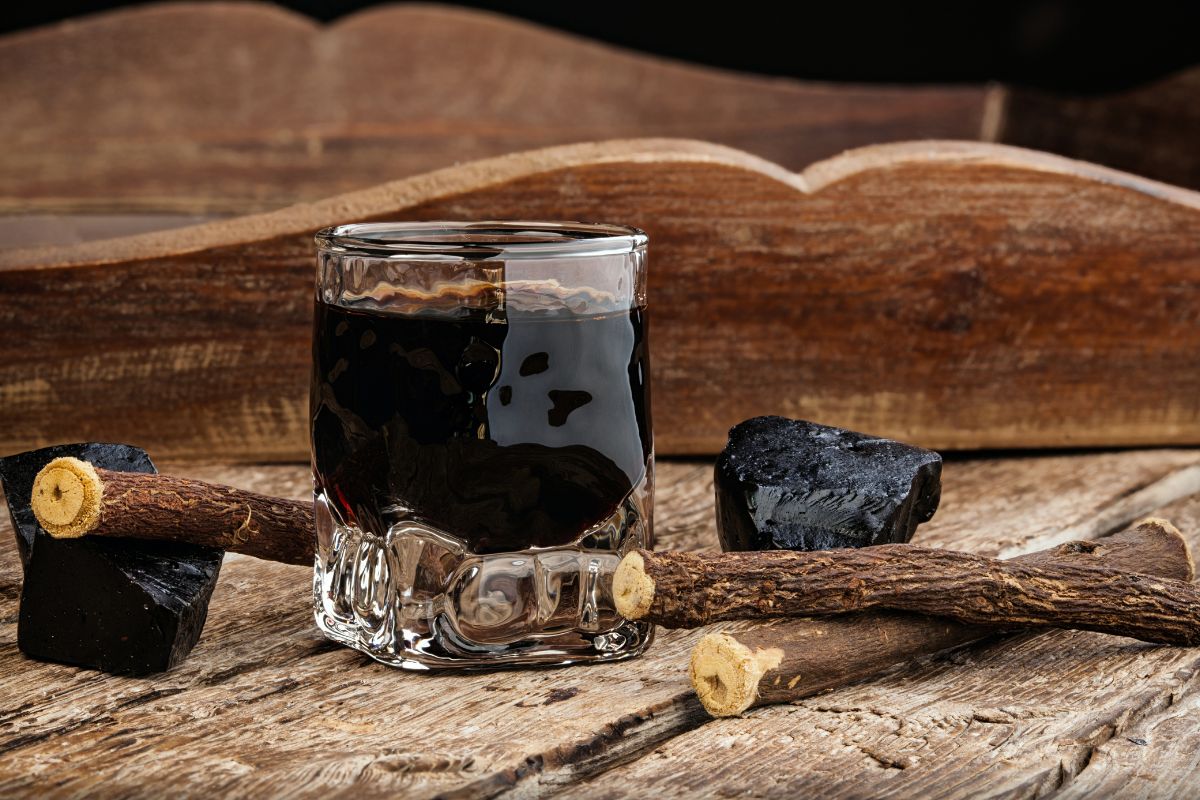
Licorice liqueur is easy to prepare even at home thanks to a simple and quick recipe for making and bottling a liqueur with a very particular taste. It can also be an excellent gift idea to give to our friends or family on special occasions.
It can be enjoyed as a digestive after a meal, or to garnish ice cream, a slice of cake or other desserts.
The only precaution is that it should be served very cold and after having shaken the bottle well, to enjoy its delicious flavour. It should then be stored in the refrigerator, ready to be served to your guests who will be impressed by its unique and original taste and fragrant aroma.
How to make licorice liqueur
Black as night, licorice liqueur has a scent that engages the senses. The intense and enveloping flavor of licorice becomes a truly unique drink, with a strong and decisive taste, perfect after a meal.
It is in Calabria, particularly on the Ionian coast, that licorice has been grown since the mid-16th century and there are so many specialties based on this plant that can be tasted in those parts.
The recipe is quite simple, but the result is guaranteed. You will make a great impression with your guests, serving it at the table nice cold and after eating.
The recipe for homemade licorice liqueur
Licorice liqueur
Ingredients
- 100 g pure and chopped licorice
- 1200g water
- 1100g sugar
- 1 l alcohol 90°
Instructions
-
Dissolve the licorice in a bain-marie in 600 g of water by placing it in an airtight container to be shaken from time to time, until complete dissolution is obtained.
-
Once the licorice has completely melted let it cool.
-
Dissolve the sugar in the remaining 600 g of water over a very low heat and once the sugar has dissolved too let it cool.
-
When both the licorice and sugar mixtures have completely cooled, combine everything in a single container and add the alcohol at 90°, stirring constantly.
-
Bottle the liqueur and keep the bottles in the refrigerator for about a week. Before serving, shake the bottle well.
Nutritional properties and use on a diet
As good and fragrant as it is, licorice liqueur has only one flaw: it has many calories thanks to the combination of ethanol and sugar and very few nutritional properties.
Licorice (botanical name Glycyrrhiza glabra which means “sweet root”) contains mainly starches and carbohydrates, with a modest amount of fat and protein.
It is a good source of mineral salts and very precious compounds, namely coumarins and flavonoids, substances with antioxidant activity.
However, alcohol is predominant and must be disposed of by the liver, with more effort if you drink more than you should. According to INRAN, the National Research Institute for Food and Nutrition, the caloric equivalent of a gram of alcohol is equal to 7 kcal.
For this reason it is best consumed in moderation. A very small glass once in a while is the perfect amount to enjoy all the qualities of this excellent liqueur.
3 good reasons to make licorice liqueur at home
It is a liqueur to be sipped all year round but certainly Christmas is the most “greedy” occasion in which to have it available.
Not only for its intense taste, but also because it helps conviviality and there are at least 3 good reasons to make a small home supply of licorice liqueur.
Excellent digestive after a meal
Often when you are with friends and relatives you tend to eat a little more or cook more elaborate dishes which often require a little slower digestion.
The properties of licorice then come to our aid. It is a root, in fact, very useful for counteracting abdominal swelling or heartburn and is effective in improving digestion, even if you suffer from constipation.
Perfect paired with sweets
There are several desserts to pair with licorice liqueur. For example, to dip ladyfingers instead of coffee for an original and delicious tiramisu, to replace alchermes in trifle or to prepare a delicious cream with a unique scent. But it is perfect above all on ice cream at the end of a meal.
When it’s cold
For those who suffer from the cold, to warm up on cold winter evenings, licorice liqueur comes to the rescue as an anti-cold cordial, whether you return home shivering from winter temperatures, or to “warm up” an evening in which you want to treat yourself to a cuddle .
In fact, the licorice liqueur is appreciated on the palate for its bitter-sweet taste and then grants the typical sense of warmth of the distillate that warms the body.
A bit of history
Also called “black gold of Calabria”, the licorice liqueur is due to the Benedictine monks, who in the year 1000 used licorice to facilitate digestion and for its diuretic properties.
Licorice has a very ancient history, but for that of Calabria we have to go back to the 1700s, when production began.
What makes Calabrian licorice special is the bittersweet taste of the roots, influenced by the soil in which it grows spontaneously, especially along the Ionian coast, but not only.
The first ashlar was born around 1700 thanks to the Duke of Corigliano. Here licorice was processed for food use and from here also the trade started which, over time, proved to be particularly profitable.
The denomination of “Calabrian licorice”, however, dates back to the early 1900s to distinguish it from other productions outside the area.
However, after the Second World War, the luck of this product suffered a setback and almost all the companies that processed licorice closed.
Since 2011, Calabrian licorice has obtained the PDO denomination from the European Union.
